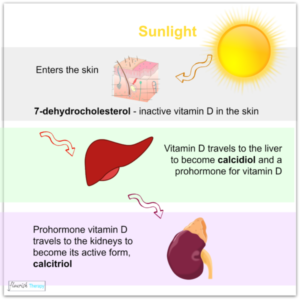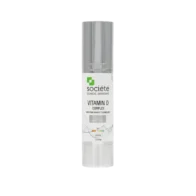If you are aware, or care about how to be healthy, you are likely to be a little confused about the Sun and, more relevantly, the UV rays which come from it. We are told to protect ourselves and our children from the potentially damaging Ultraviolet Light which the sun puts out and which is apparently stronger in more recent times because the ozone layer has a hole in it. Then we are also told we need to have sufficient Vitamin D, which comes from sunlight, in order to be healthy! In case you weren’t aware – our body, in our skin, creates Vitamin D via the sunlight which penetrates it and Vitamin D is an essential ingredient in making our entire body, brain and skin -healthy!
AGHHHHHHH – I hear the cries – what am I supposed to do?
Let’s discuss Vitamin D as an anti-ageing agent
There is no doubt that Vitamin D, actually a hormone not a vitamin, is an essential, indispensable part of what gives us healthy skin. It is necessary in fact, to keep our skin healthy, smooth and soft. We get it by allowing the sun to touch our skin and therefore allowing UV’s to penetrate. It is this sunlight which creates the Vitamin D so essential to our skin’s and our body’s well-being.
Unfortunately, it is this same sunlight which, over our lifetime, damages the skin. Giving us fine lines, wrinkles, brown spots, dullness, rough texture and increasing our chance of developing skin cancers.
How does sunlight make Vitamin D

The active form of Vitamin D is Calcitrol, which is created in the top layer of the skin – the epidermis. It starts when sunlight hits the skin, or more correctly UVB. Then a set of biochemical reactions begin which evolves sunlight into Vitamin D. This then turns into the hormone Calcitrol. Calcitrol is one of the most powerful hormones in the body. It can activate over 2000 genes (around 10% of the total). Influencing their “expression” and therefore turning off and on various functions for each cell. They are directly involved with cell growth, metabolism, differentiation and optimising cell immune function. So, you can see we absolutely need it!
It is important to note that our skin is designed to be exposed to some sunlight. Otherwise why would the mechanism of Vitamin D creation be placed there and need sunlight to facilitate its production.
Everyone is different of course. It’s important to be aware of how much sunlight our individual body can defend against before turning pink. We have our melanocytes and melanin to protect our cells and, depending on how many of these we have we tan or turn pink, and hopefully not red.
At the mildly pink stage stage we should have our Vitamin D for the day!
Interesting Facts about Skin and Vitamin D
It is interesting to note that as we age our skin loses about 75% of its ability to produce Vitamin D3. This comes in the chemical changes between the sunlight and Calcitrol. When you know this, you realise that as you get older your daily “D pill” is a vital part of you staying healthy, as well as looking good as you age. Sunlight can only do so much. Another important fact is that the body steals most of the Calcitrol, that is made in the skin, to use throughout the body. Where it is busy keeping cells doing what they should. The small amount left works hard keeping our skin functioning optimally and keeping us looking potentially as healthy and young as possible.

Limited exposure to the sun, it is thought, actually strengthens the skin. Preventing premature ageing as well as minor sunburns. So don’t hide your skin completely from the sun all the time.
It has been said that as Vitamin D is a fat-soluble vitamin it is best absorbed through our larger areas – our buttocks, thighs and tummies. Maybe we can save our faces after all.
Unlike other vitamins, we do not need to get Vitamin D from foods. We should get enough from UV exposure. Again, this is dependent on where you live, how much time you spend outside and whether you allow your skin to be exposed.
Vitamin D is essential – what does it do in the skin?
- Cell replacement
- Cells are dying constantly in the skin and the amazing Calcitrol is responsible for the healthy replacement of around 30-40,000 a minute!! This happens in the keratinocytes, situated near the surface of the skin and account for around 95% of the overall skin’s cells.
- Cellular metabolism is improved – YAY. This is what we need as we age!
- Watertight barrier
- Keratinocyte cells also create the framework for the skin. The layer which holds everything together. If this is healthy, moisture is locked into the cells, assisting in keeping skin supple and soft. It cannot do this without Calcitrol.
- Immunity is increased and inflammation is decreased
- The epidermis is the top line of defence against bugs, germs, bacteria and all pathogenic “invaders.” Therefore when the keratinocyte layer is healthy you are less likely to contract nasty infections. Also any burns or skin injuries will heal faster if you have good levels of Vitamin D in your skin.
- In the presence of Calcitrol, free radicals or damaged cells, can be repaired or destroyed. Slowing down the ageing process in the skin and keeping your skin healthier.
- It is useful in the treatment of rosacea, eczema and psoriasis, decreasing inflammation, improving hydration and normalising cell function.
If we don’t allow ANY sunlight on our skin, our body struggles as a whole,
and yet if we allow TOO MUCH sunlight then we damage our skin.
How to get enough D safely
- Ensure you have sunlight exposure daily for 20-30 minutes, avoiding the middle of the day in summer and considering the weather where you live. Perhaps it’s time to exercise… try to expose your arms, legs and tummy – go for it girls!
- There are helpful apps (such as the Sun Smart app) available that show the current UV rating for where you live and recommend when to use sun protection… you don’t have to guess!
- Be aware that the skin on your face is thinner than in other areas so if you are concerned about damaging your skin or premature aging then this is the area to protect with sunblocks and hats.
- U
se a Vitamin D topical treatment such as Societe Vitamin D Complex if you live in areas that are known for low sunlight, or you are avoiding sun exposure.
- Use a physical sunblock, sunglasses and a hat during the high UV rating times. Zinc is a much safer ingredient that any of the other ingredients which are in chemical sunscreens. The Colorescience powder is easy – just brush it on when you need it – even over makeup. If you hate the feeling of wearing sunscreen, don’t worry, we understand! That’s why we’ve found sun protection options that DON’T feel greasy on your skin.
- Fake tan doesn’t block UV’s, however it might stop how your skin utilizes them depending on the brand and your skin.
- Eat well, including oily fish, vegetables, eggs, beef and foods fortified with Vitamin D such as cereals, soy milk and some orange juices. Include supplements where necessary to improve your overall health.
- Take a Vitamin D pill daily, including Calcium and Magnesium, especially in winter and especially if you live in a cooler climate.
And one I love – After you’ve been in the sun and feel Vitamin D topped up, put off having a shower for as long as possible. After UV exposure a powdery substance is produced by the skin which is slowly absorbed into the skin and converted into Vitamin D. Washing it off too soon results in a lower daily Vitamin D level!
There is so much to write about the importance of Vitamin D for the whole body. We have just touched on how it works and the effect it has as an anti-ageing agent on your skin.
Enjoy getting out there safely, exposing the larger areas of your body and reap the rewards as you stay healthier and younger!
Best Selling Skin Care Options
If you need any help in choosing your skin care, you can email us at info@theskincareclinic.com.au.
-
Societe Vitamin D Complex
$199.00
Still not sure?
Do you need more help or would like personalised advice? Book now for your consultation with a skin care advisor. Offering information on what skin care products are best for you. Check out our range of in-clinic services today.
Otherwise fill in the Online Skin Consultation. Our skin care advisor will happily help you. Choosing the right treatments and products for your skin type or concern.
Check out our latest Specials!


 se a Vitamin D topical treatment such as
se a Vitamin D topical treatment such as 

Leave a Reply